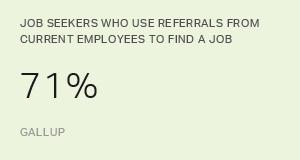Story Highlights
- Poor onboarding puts performance and new-hire retention at stake
- Remote onboarding adds a new challenge for leaders
- Managers must be prepared for their role in onboarding
Onboarding is about much more than "Where do I sit?" and learning the ropes of the job.
Onboarding is a journey -- a foundational part of your employee experience. It's about fulfilling the promises you made during recruitment and preparing employees to be high performers. When it goes well, employees feel a sense of belonging and learn what defines their success.
Unfortunately, only 12% of U.S. employees say their company does a good job of onboarding. Complicating matters further, leaders have a brand-new onboarding challenge: helping remote workers develop relationships and learn their role in a virtual setting. And according to Gallup analytics, nearly one in five employees either report that their most recent onboarding was poor -- or that they received no onboarding at all.
More than ever, leaders need rich onboarding experiences that help remote workers integrate with the company and become productive team members.
According to Gallup analytics, one in five employees either report that their most recent onboarding was poor -- or that they received no onboarding at all.
What's at stake are outcomes like performance and new-hire turnover. For example, 70% of employees who had exceptional onboarding experiences say they have "the best possible job." These employees are also 2.6 times as likely to be extremely satisfied with their workplace -- and consequently, far more likely to stay. Simply put, to get exceptional employee outcomes, you need exceptional onboarding.
To help leaders create exceptional onboarding experiences, Gallup asked employees to describe the most valuable aspect of their most recent onboarding experience. Employees shared a variety of answers, but three common themes emerged: people, learning and processes.
1. People: Foster meaningful relationships.
Onboarding is all about connection. For many employees, the most valuable aspect of their most recent onboarding experience was the human element -- meeting people, forming social ties and learning from their colleagues.
New employees want relationships that make them feel supported, included and respected. They value candid feedback and clear communication, particularly from leaders and managers. They want to meet lots of people, ask questions and receive mentoring from colleagues who genuinely care.
That is, new hires have their best onboarding experience when they respect their partners and trust that their coworkers are committed to excellence.
2. Learning: Show new hires where they can contribute.
Workers enter your organization with a plethora of questions -- like "What is this place about?" and "How do I fit in?" They crave answers and learning experiences that will help them reach their full potential. So it's of little surprise that many employees consider learning to be the most valuable aspect of their onboarding journey.
Yet only 29% of new hires say they feel fully prepared and supported to excel in their role after their onboarding experience.
While things like role training and computer setup are necessary, the most important discoveries for new hires pertain to the fundamental psychological needs every employee has, such as understanding shared cultural values and learning "how we do things around here."
Enter the manager. Gallup research shows that the effectiveness of an onboarding program is largely contingent on the manager's active involvement in the process. Managers are central to learning: They must clarify job expectations, explain big-picture goals and help new hires collaborate with their teammates.
Simply put, to get exceptional employee outcomes, you need exceptional onboarding.
Further, the example that managers set helps new hires get acquainted with cultural norms and values. Ultimately, when the manager takes an active role in onboarding, employees are 3.4 times as likely to feel like their onboarding process was successful.
3. Processes: Create a journey that's intuitive and easy.
The structure and execution of your onboarding program are also paramount: For many employees, the most valuable aspect of their onboarding journey was simply how it was organized and delivered. Employees want clear expectations for training and orientation, a well-defined onboarding structure, and a pace of learning that makes them feel well-prepared.
Shiny onboarding technology platforms might seem like the perfect answer, especially in the era of remote work. However, these programs can have a steep learning curve -- and don't show new hires how they fit into the culture.
For many employees, the most valuable aspect of their onboarding journey was simply how it was organized and delivered.
Organizations with world-class onboarding programs rely on analytics to design a process that not only answers the five questions of onboarding but also makes sense for their company.
For example, some employees want highly structured onboarding. For other roles, a flexible, evolving process is ideal. With the right data, leaders can tailor their program to meet employees' needs and the demands of the job. When it comes to exceptional onboarding, there's no one-size-fits-all.
Remember, onboarding is a journey -- and it takes longer than you think. Gallup's experience suggests that new employees typically take around 12 months to reach peak performance potential. New hires need time to shadow colleagues, master workflows and collaborate with key players.
Practical Advice for Leaders
In Gallup's experience, great onboarding involves far more than on-the-job skills training. The following strategies can help leaders excel with the people, learning and process components of their onboarding program -- and ultimately, create a holistic onboarding journey that engages even the most scattered remote workforce.
-
Find creative ways to build connections. At the office, relationship-building comes naturally during "water cooler" moments. For remote new hires, leaders need to think outside the box -- even to the point of scheduling small talk. For example, through monthly "coffee chats," new hires can get to know colleagues they don't typically work with, develop true friendships and uncover mentorship opportunities. Leaders should set an example, modeling the types of relationships they expect new hires to maintain.
-
Encourage tenured employees to reach out. A brief, genuine encounter with a leader or team member can leave a lifelong impression on a new hire. For example, a message asking, "How was your first week?" not only is welcoming, but it also liberates new hires to ask questions and be confident about whom they can go to for advice.
-
Lean into learning. A new hire is eager to learn about their job. But Gallup research shows that valuable learning experiences offer far more than role-specific training. Exceptional onboarding programs explain the history and origins of the company -- and perhaps more importantly, how the new hire's work promotes the greater mission and purpose of the organization. When employees understand why and how their job fits into the bigger picture, they can start delivering brand promises faster.
-
Add experiences that bring your culture to life. Onboarding should be an invitation for new hires to participate in your culture, whether that's a culture of innovation, customer-centricity or competition. This requires both communication and firsthand experiences: New hires need to see and feel how your culture plays out and how they fit into it. For example, your onboarding journey might highlight case studies about world-class customer service to teach new hires how they're expected to embody your customer values. Or if your culture emphasizes ethics and compliance, your onboarding journey might include a deep dive into your incident reporting process.
-
Send a welcome package. A "care package" with gifts or handwritten notes can speak volumes to new hires, making them feel seen and valued. Plus, through human connections, leaders have an opportunity to reinforce their work culture and core values -- reassuring new hires that they're in the right place.
-
Create a formal mentorship program. Job seekers are on the hunt for development, coaching and mentorship. To meet this need -- and promote retention -- leaders should pair new hires with a mentor or adviser who can answer their questions and help them learn and grow. Trust and team cohesion form rapidly when teammates go the extra mile to mentor and invest in their newest members.
-
Prepare managers for an active role. Managers must be present, involved and available throughout new hires' onboarding journey. Managers are culture conduits who must embody shared values and provide learning experiences that bring the culture to life. With the right development and training, managers can become coaches who immerse new hires in the culture, connecting them with the right people and providing the support and mentoring they need.
- Use data to optimize your program. Organizational analytics -- such as quality-of-hire metrics -- can illuminate everything from risk points for turnover to strategies for reaching high performance faster. Gallup has helped leaders assess the current state of their onboarding program and use those insights to find best practices, establish standards for success and track program efficacy.
Nearly every organization has an onboarding program, yet few employees say their onboarding experience was great. The reinvention of onboarding is not just overdue; it's necessary for success in the post-pandemic workplace.
That is, if leaders want to compete for talent -- not to mention keep it -- they need to create an onboarding journey that can only be described as exceptional.
A better employee experience starts with better onboarding:
- Learn more about how your organization can develop a people-centric approach to onboarding.
- Partner with Gallup to optimize your approach to onboarding.





